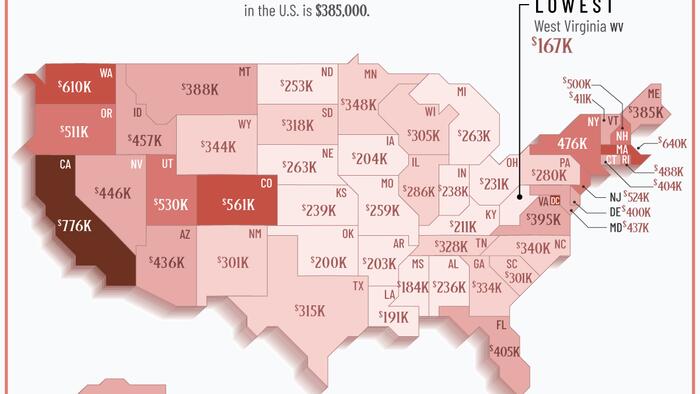In 2024, the landscape of home buying across the United States exhibits significant variability, heavily influenced by regional factors such as demand, land availability, economic conditions, and housing regulations. As of August 2024, the median sales price for a single-family home in the U.S. stands at approximately $385,000, but this figure masks a wide range of pricing across different states. A recent visualization by Visual Capitalist, based on updated data from ATOM, showcases these disparities as the median home sale prices from various states reveal stark contrasts shaped by local market conditions.
Hawaii leads the nation with the highest median home price at about $851,930, a value that is more than double the national average. The exorbitant costs are driven primarily by limited land availability, stringent housing regulations, and significantly high demand due to its favorable climate. A detailed report from the University of Hawaii highlights that regulatory costs account for a staggering 58% of the median price of new condominiums in the state, reflecting the complexities of the housing development process. Furthermore, Hawaii’s small land area coupled with strong tourism and military presence serves to continuously escalate property prices, creating a particularly challenging market for potential home buyers.
Following Hawaii, California captures the second spot with a median home price of $776,000. Renowned for expensive metropolitan areas such as Los Angeles and San Jose, California faces a home price-to-income ratio exceeding 10 in many regions, highlighting the unaffordability crisis in the real estate market. The state’s desirable attributes, including cultural, economic, and recreational opportunities, maintain robust demand, further exacerbating the price issue. Comparatively, more rural states like West Virginia and Mississippi exhibit markedly lower median home prices, at approximately $167,000 and $184,000 respectively, emphasizing the economic divide present within the country’s housing landscape.
Moving down the list, states like Massachusetts ($640,113) and Washington ($609,540) showcase prices that still remain considerably elevated due to local demand and economic conditions. Massachusetts, home to numerous prestigious educational institutions, sees high demand from both residents and investors, contributing to its elevated price point. Similarly, Washington’s robust economy and technological growth, particularly in cities like Seattle, create a marketplace with strong demand against limited housing stock.
Several states exhibit median home sales prices just above the national average, signaling a diverse economic environment. For instance, Colorado ($561,205) and Utah ($530,041) reflect appealing outdoor lifestyles, drawing in residents looking for a higher quality of living. These states have become popular destinations for individuals relocating from higher-priced markets seeking more affordable yet desirable living accommodations. In contrast, states such as Kentucky ($211,235) and Iowa ($203,770) present a less frenzied housing market, characterized by lower demand and more stable prices.
The ongoing conversation about housing affordability touches upon regulatory, economic, and geographical factors, influencing the broad spectrum of home prices across the U.S. As homeownership remains a key aspect of the American dream, navigating the complex real estate landscape calls on potential buyers to weigh their options meticulously against personal financial circumstances, location preferences, and market trends. As illustrated in the data, understanding regional differences in housing prices is crucial for making informed decisions in an increasingly multifaceted market.

